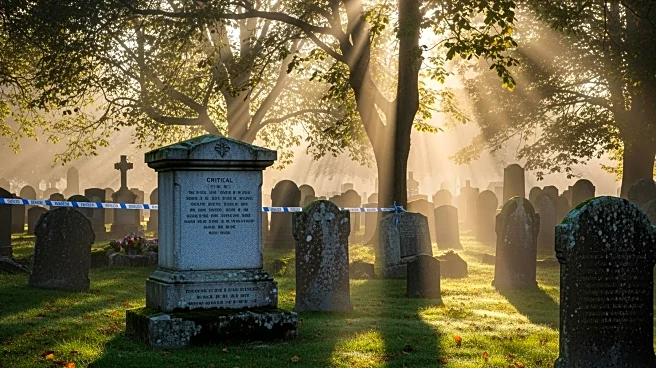What's Happening?
Hasidic pilgrims visiting the graves of Vizhnitz dynasty leaders in Vyzhnytsia, western Ukraine, discovered that vandals had desecrated several graves in the historic cemetery. Witnesses reported that intruders
broke through the cemetery fence, trampled, and destroyed several tombstones, causing extensive damage. This incident occurred shortly after the memorial for the 'Tzemach Tzadik' of Vizhnitz, a founding rabbi of the dynasty who died in 1884. Despite the damage, the prayer tent and guesthouse were unharmed, likely due to security cameras in the area. Representatives from 'HaGan HaNa’eh' and 'Hachnasat Orchim' organizations filed a police report, prompting local authorities to open an investigation to identify those responsible.
Why It's Important?
The desecration of the Vizhnitz dynasty cemetery is significant as it highlights ongoing issues of antisemitism and vandalism against Jewish sites in Ukraine. The incident has caused distress among the Hasidic community, who travel from around the world to pay respects at the graves of their leaders. The act of vandalism not only disrespects the deceased but also threatens the cultural and religious heritage of the Jewish community. The investigation by local authorities is crucial in addressing these acts of hate and ensuring the protection of religious sites, which are vital for cultural preservation and community identity.
What's Next?
Local authorities have initiated an investigation to identify the vandals responsible for the desecration. The outcome of this investigation could lead to increased security measures at the cemetery and other religious sites to prevent future incidents. Community leaders, including Rabbi Moshe Hersh Stern, have expressed their commitment to restoring the cemetery and preserving its sanctity. The incident may also prompt discussions on broader measures to combat antisemitism and protect religious heritage sites in Ukraine.
Beyond the Headlines
The desecration of the Vizhnitz dynasty cemetery raises broader ethical and cultural concerns about the protection of minority religious sites in regions with historical tensions. It underscores the need for international cooperation and support to safeguard cultural heritage and promote tolerance. The incident could lead to increased advocacy for stronger legal protections and community engagement to prevent similar acts of vandalism.












